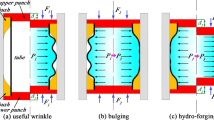Abstract
The loading path affects the metal formability remarkably in tube hydroforming, and it is also one of the research focuses. Recently, some scholars abroad proposed a new fluctuant hydraulic loading method, which can improve the formability of tubes in hydroforming. Related studies have shown that this new loading method can improve the tube formability, the distribution of deformation is more uniform and this is useful for avoiding excessive local thinning. In this paper, tube hydroforming experiments without axial feeding were carried out; the influences of the loading methods on formability of stainless steel tubes were studied. Through the comparison of the experimental results under the condition of monotonous increase loading and fluctuation hydraulic loading, the outside diameter distribution, the thickness distribution and the crack expansion forms of deformation zone all fully prove that the uniformity of the distribution of tube deformation and formability have been increased significantly under the condition of fluctuation loading without axial feeding, the reasons should be distinguished from the fluctuation hydroforming with axial feeding. In order to study the forming mechanism, uniaxial tensile test of tubes similar to fluctuation loading deformation is designed in this paper, namely intermittent tensile test. It is found that intermittent uniaxial stretch can improve the tube elongation at fracture by about 40% and the deformation distribution is more uniform than that through uniaxial tensile test of the stainless steel tube. In the process of intermittent tensile tests, changes of metal microstructures brought by the loading and unloading processes are the main reasons that improve the formability of the tubes.
Similar content being viewed by others

References
Dohmann F, Hartl C. Hydroforming — A method to manufacture light-weight parts. J Mater Process Tech, 1996, 60(1–4): 669–676
Ahmetoglu M, Altan T. Tube hydroforming: state-of-the-art and future trends. J Mater Process Tech, 2000, 98(1): 25–33
Hama T, Ohkubo T, Kurisu K, et al. Formability of tube hydroforming under various loading paths. J Mater Process Tech, 2006, 177(1–3): 676–679
Koc M. Investigation of the effect of loading path and variation in material properties on robustness of the tube hydroforming process. J Mater Process Tech, 2003, 133(3): 276–281
Imaninejad M, Subhash G, Loukus A. Loading path optimization of tube hydroforming process. Int J Mach Tool Manu, 2005, 45(12–13): 1504–1514
Ray P, Mac D B. Determination of the optimal load path for tube hydroforming processes using a fuzzy load control algorithm and finite element analysis. Finite Elem Anal Des, 2004, 41(2): 173–192
Heo S C, Kim J, Kang B S. Investigation on determination of loading path to enhance formability in tube hydroforming process using APDL. J Mater Process Tech, 2006, 177(1–3): 653–657
Mori K, Maeno T, Maki S. Finite element simulation of hammering hydroforming of tubes. TUBEHYDRO 2003, 2003. 80–83
Loh-mousavi M, Mori K, Hayashi K, et al. 3-D finite element simulation of pulsating T-shape hydroforming of tubes. Key Eng Mater, 2007, 340: 353–358
Manabe K, Amino M. Effects of process parameters and material properties on deformation process in tube hydroforming. J Mater Process Tech, 2002, 123(2): 285–291
Hama T, Asakawa M, Fukiharu H, et al. Finite element simulation of hammering of an automotive component. TUBEHYDRO 2003 (Japan), 2003. 80–83
Yuan A Y, Zhang S H, Sun Y Y, et al. Finite element simulation of pulsating tube hydroforming. J Mater Sci Eng, 2009, 3(3): 1–7
Mori K, Maeno T, Maki S. Mechanism of improvement of formability in pulsating hydroforming of tubes. Int J Mach Tool Manu, 2007, 47(6): 978–984
Taleb L, Hauet A. Multiscale experimental investigations about the cyclic behavior of the 304L SS. Int J Plast, 2009 (in press)
Tsuzuki H, Branicio P S, Rino J P. Molecular dynamics simulation of fast dislocations in copper. Acta Mater, 2009, 57(6): 1843–1855
Blum W, Zeng X H. A simple dislocation model of deformation resistance of ultrafine-grained materials explaining Hall-Petch strengthening and enhanced strain rate sensitivity. Acta Mater, 2009, 57(6): 1966–1974
Wang Z X. Physical Metallurgy of Plastic Working (in Chinese). Beijing: Metallurgical Industry Press, 2003
Author information
Authors and Affiliations
Corresponding author
Rights and permissions
About this article
Cite this article
Zhang, S., Yuan, A., Wang, B. et al. Influence of loading path on formability of 304 stainless steel tubes. Sci. China Ser. E-Technol. Sci. 52, 2263–2268 (2009). https://doi.org/10.1007/s11431-009-0213-2
Received:
Accepted:
Published:
Issue Date:
DOI: https://doi.org/10.1007/s11431-009-0213-2


